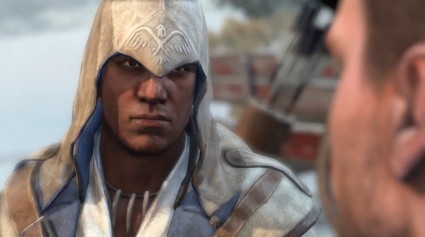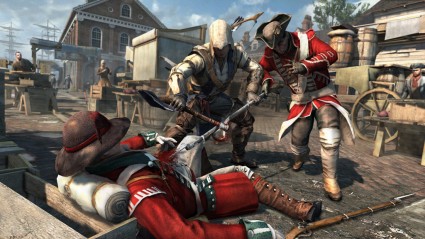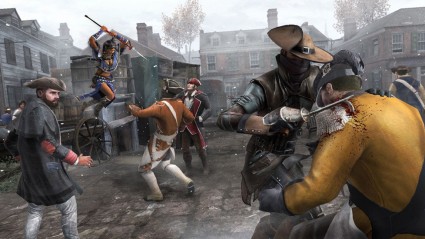Reviews
Assassin’s Creed III
December 5, 2012, Author: Trent Pyro
From the moment it first touched down on Xbox 360, the Assassin’s Creed series has been at the forefront of cutting-edge action stealth gameplay. From Altair’s journeys through Crusade-era Syria, to the tale of Renaissance-man Ezio Auditore stretching across three epic titles, the series has also allowed us to experience history like never before. After the resounding success of Ezio’s plotline, Ubisoft are looking to bring main protagonist Desmond’s story to a close also with Assassin’s Creed III.
Have they managed to bring this most epic of series to a satisfying close? Has the departure of fan-favourite Ezio spelled doom for the franchise? Worry not Assassin’s fans; Ubisoft know exactly what they’re doing, and we never should have doubted them.
An American tale
Creeping ever closer to the present, AC3 is set firmly within the time of the American Revolutionary War. You play Connor Kenway, a young English/Native American bloke who’s trained as an assassin to save his village from fiendish Templar agents. At the same time, Desmond and co have discovered a cave full of artifacts from the Ancient Ones and are pretty much racing against time to find the final Piece of Eden, before the world bites the dust on, you guessed it, December 21st 2012.
As with his ancestors, Connor’s story is a personal one, with his dedication to the Assassins and fight against the Templar’s neatly woven in. What begins as a simple wish to save his people soon blooms into a fight for a cause. The Sons of Liberty are his chief point of contact, as it seems the Templar agents are firmly on the side of the British. George Washington, Paul Revere and Sam Adams are just a few of the well-known historical figures you’ll be rubbing shoulders with, lending the game an air of authenticity that the series is known for.
The tale of the war, sticking with history pretty much to the date, is more than interesting enough to underpin the overall Assassin/Templar conflict. Getting the chance to take part in the Boston Tea Party and be around for the signing of the Declaration of Independence is pretty cool, although I imagine will mean more to our American cousins than everyone else.
You may notice I’ve been talking around specific plot points. The thing is, with this being the culmination of Desmond’s overarching story and possibly (although not probably) the final game in the series, it’s jam-packed with spoilers and revelations that will make seasoned series veterans leap from their sofas in joy and surprise. Simply revealing how the game opens and how Connor’s story begins would involve divulging a small fact that has massive implications.
It’s a testament to Ubisoft’s writing team that the plot is so compelling and has been written with long-term fans in mind, but I fear the level of back-referencing may alienate some newcomers. Although not ‘getting’ everything should be expected if you come in at the third (or fifth) game in a series, there’s enough content exclusive to AC3 to make it an exciting and enthralling story regardless of your previous experience.
Connor himself is at first a dull man with little expression. While the voice actor does a decent job of conveying his dual heritage and tough upbringing, it’s difficult to view Connor as anything more than a weapon in the first few hours. Once he becomes more embroiled with the Revolution and begins to see how the web connects, he begins to show himself as a fiercely driven and focused man with no thought for anything but the completion of his mission.
While this is endearing from a simplicity point of view, it leaves something to be desired when compared to Ezio’s deft handling of wit and charm. As usual, however, Connor is the perfect character for the setting and story, and after the initial few sequences you’ll doubtlessly warm to him as I did.

Don't be fooled by his mute expression...
Aside from the main quest-line there’s a host of side quests, mini-games and activities to keep you busy in the game’s locations. Letters need delivering, citizens need saving from the evil Redcoats, and occasionally historical figures will pop up asking for your help. While none of these will tear you away from the main plot for long, they’re necessary and welcome inclusions in such a big game.Two things that will almost certainly give you a break from Connor’s quest are your homestead and the much-touted naval battles.
Early-on, Connor comes across a plot of land owned by his tutor and mentor Achilles. Tasked with doing it up and maintaining it, this little side quest-line is a neat addition and provides hours of extra gameplay. You’ll find random people in need of aid across your land and helping them will add them to your roster of workers. Blacksmiths, woodcutters and hunters are just a few of the trade and craftspeople you’ll accrue and they all have their uses.
Using the accounts book in the manor house, you can set up trade caravans and do business with any general stores you’ve found in your travels. This generates a healthy profit for Connor and is one of the few ways to earn money, with the chests and caches of Renaissance Italy being almost entirely missing from 18th century America.
Each caravan trip carries a risk of hijack and failure, with the most irritating times being when you get a message claiming you ‘failed to protect your caravan’ even though the game never told you it was in danger, and there seems to be no way to escort it. You can also hunt game within your borders, although while this is a fun distraction it’s not enough to hold your attention for too long.
As soon as you rebuild the wrecked ship sitting in your homestead lake, you’ll be able to take her out on the seas of the East Coast and make like a pirate. It’s a brilliant feeling taking the helm as you guide your boat through rock formations, calling out sail and cannon orders and watching your crew bolt around doing your bidding. As the waves crash around you and the cannons roar, you’ll get a feeling unlike any other.
Disappointingly though, the naval missions are plagued with issues, mostly down to the difficulty. While the first couple of missions are a heady mix of ‘oh my God I’m sailing a ship like a fucking pirate!’ and learning the tricky but intuitive controls, the difficulty skyrockets once you leave the safety of the tutorial. You’ll regularly be swamped by multiple smaller, faster ships that can fire twice as fast as you can and cut around you so quickly you can barely get a bead on them.
The initially simple control system becomes an albatross around your neck and you’ll be cursing your ship’s sloth at every turn. The camera is abysmally poor, with what’s in front of you being almost impossible to see. I suppose it’s an attempt to emulate Connor’s field of view as he mans the wheel, but when you have to shoot minefields before you hit them realism isn’t much of a consolation.
Missions are regularly comprised of multiple, tough objectives that overestimate your abilities. Protect this ship from 20 other ships while staying alive, then chase some more ships through a minefield and finally catch and destroy this faster, tougher and better-sailed ship. All on one health bar, with only a mostly-useless ‘Take Cover’ move to protect you.
Pleasingly simpler, however, are the Liberation missions. By completing mini-tasks in a certain district you gain the ear of a local revolutionary who can help you roust the Templars. Complete his or her request and another final mission and the district is yours. Controlling each district grants bonuses and it’s probably the most worthwhile side-quest to pursue.
Tricks of the trade
Getting the job done without being seen has never been easy in Assassin’s Creed, but this time around it can be almost impossible. Redcoats have eagle-like vision, spotting you from miles away. They hang around in groups of three or four, and their patrol patterns constantly criss-cross and overlap. Making just one kill can be a matter of waiting an age for just the right second, with very little chance of keeping quiet if you mess up. New cover such as bushes and tall grass, as well as the ability to sort-of hide around corners, does help but not a great deal.
Missions will regularly throw ‘kill 15 enemies’ objectives at you and then highlight a tight platoon of Redcoats, making it impossible to pick them off quietly. While I’ve always preferred to scrap my way through the AC games, it seems out-of-character for the series to push so much open combat on you. The stealth-only missions can become tedious grinds because of this, making you often wish you could just fuck everyone up and be done with it. Thankfully, when the shit does hit the fan, the one thing Connor has going for him is his ability in open conflict.

Connor plays the Redcoats like a particularly bloody fiddle
Tearing through Redcoats like a rabid wolf, his dual-wielding prowess is a sight to behold and is worlds away from Ezio’s gentlemanly swordplay. A tomahawk and dagger are Connor’s weapons of choice, and he uses them, and the myriad of other available tools, with a ferocity more akin to an animal than a human.
Making it all work is the brand-new combat system. Finally shedding the puppet-style of the original Animus completely, you instead have a simple but adaptable system that really refines the possibilities of an assassin. You can equip one weapon (although Connor will adapt to use a second simultaneously) and one tool, as well as being able to block, dodge, counter, disarm and stun foes with ease.
It all hinges on the new Counter button. Tap it as an enemy attacks and you get a brief period of extremely slow-motion, with each face button now performing a different action. Attack with either equipped item and you’ll perform an instakill move, although you can also throw or disarm your opponent as the situation suits. With many different kinds of enemy needing a range of tactics to beat, it becomes a game of strategy and skill akin to… well, the Batman games.
It’s impossible to get away from the similarities here; the red markers flagging enemies attacks, the slick counters, the various tactics needed to beat the various types of enemies. While it does expand far beyond Batman’s simple attack/counter mechanics, it’s not quite as elegant as previous systems and can sometimes feel a little too easy.
Though you can grab an enemy and swiftly use him as a shield against a line of riflemen, or manage a counter against two opponents, and be treated to a fantastic dual-kill move. It’s plain to see that Ubisoft wanted to expand the combat system without overcomplicating it, and they’ve managed to do that with aplomb.
Getting away when you’re overwhelmed has never been easier, with all the free-running stuff now contained on the Right Trigger. While holding A will allow you to quickly parkour your way over fences and such and you do need to tap a few buttons to perform certain actions, the system has been perfected to the point where you’ll rarely have to; just hold that trigger and away you go.
Connor’s ability to climb trees is mesmerising, as he deftly leaps and swings from branch to branch with little effort. Certain doors and windows will allow you to run through a building to dodge pursuers and there’s nothing cooler. It’s generally the final, mastered form of a system almost unique to the series since the very beginning, and AC3 is all the better for it.
The game tries to mix it up with a few changes of pace throughout the campaign, but it’s a testament to the quality of the core mechanics that most of these distractions just make you wish you were stalking a target or fighting a huge gang of Redcoats.
The Brotherhood mechanics from Ezio’s series have been brought back, albeit with a few changes. The men who lead revolutions against the Templars during the Liberation missions become your assassin brethren, on-hand to help out in a variety of fresh ways aside from the usual ‘assassinate that bloke’ and ‘help me I’m getting battered here’ options.
The more men you unlock the greater the options, and after a while you have quite a diverse and useful bunch to give you a hand. You can also send them across the East Coast to complete missions for money, influence and XP, although they seem to level up a lot slower than before and I found myself having to keep them on-mission almost all of the time to have any chance of increasing their skills. They can also get injured now, causing them to be unavailable for a while. Great for realism, not so great when the game decides that your freshly-summoned assassin will stand stock still as five Redcoats cut him to pieces.
A mixed bag then, and unfortunately the same can be said of the visuals.
Pop ‘n’ Fresh
I’m going to come right out and say it: AC3 looks beautiful. The level of detail and fluid animation displayed is nothing short of bleeding-edge, with the Anvil Next engine looking more than ready to take on the next-generation of consoles. Connor swoops and dives and cartwheels like water, his movements meticulously mo-capped and blended with procedural animation. NPCs wander about, buy from stalls, chat, get bullied by Redcoats and generally make the cities of Boston and New York feel fantastically alive.
Of special mention is the sea; it looks photorealistic. As the waves lap at the sides of your warship and the tide swoops in and out of a bay, the only thing that gives away its artificiality is the less-realistic textures of everything around it.

No, this is not a pre-render
It’s not all puppies and rainbows though. The best way to describe AC3’s graphics would be a very handsome electrician who’s re-wired your house so all the lights flicker and the TV decides when it wants to work. While everything is rendered in glorious detail, the geriatric Xbox 360 is visibly groaning under the strain of Anvil Next. Pedestrians pop in and out at random and the engine seems to make no efforts to disguise it. Redcoats appear from no-where and then disappear for no reason, making some stealth sections impossible.
The draw distance flips between stunningly beautiful and pea-soup fog. One shot will have a character looking as close to human as possible with the tech, the next will have him swamped in muddy textures. It’s as if Anvil Next has a mind of its own and is suffering from short bursts of serial laziness.
The obvious reason is that the engine is literally screaming out for a more powerful machine. The 360 may have a couple more years left before it well and truly becomes worm food, but it’s no surprise that it finds running a next-gen engine very difficult. It does an admirable job, allowing a thrilling and compelling experience that’s only occasionally shattered by a vanishing crowd, but considering the budget, resources and talent poured into AC3, it’s not really on.
Thwack!
Sound-wise AC3 shines, even moreso than its predecessors. Weapons connect with almighty crunches, Connor’s tomahawk effortlessly cleaving its way through enemies with a satisfaction that could only be described as ‘juicy’. A focus on making gunshots loud and messy gives the rudimentary muskets carried by many of the soldiers an authentic feel, and you genuinely wince when caught under a salvo, and not just for the usual damage reasons.
The people of Boston and especially New York sound more alive than ever, with seemingly thousands more lines of random dialogue and more event-centric conversations to be overheard. No more do random NPCs shout bizarre phrases that seem to repeat ad infinitum, although of course there is the occasional overlap. The main thing Ubisoft have managed to create is a distinct sense of bustle. Sticking a bunch of characters in a crowd is great, but the way to make it feel really crowded is to have them all mumbling and talking and shouting. You feel oppressed and, in turn, masked by the noise of the crowd as well as their physical presence, and it certainly sets blending far above previous iterations.
The voice acting is, of course, top notch, with not a bad apple in there. Connor himself seems dead and flat at first, mumbling his way nonchalantly from cutscene to cutscene, but as the story progresses his deadpan humour and unwavering focus become endearing qualities and the actor does an admirable job throughout. It’ll be interesting to see what Americans make of some of the historical figures though. Not being up on American history I have never really thought about what George Washington would’ve sounded like, but I was certainly surprised by Da Vinci’s flamboyant cantor in previous games.
Special mention must go to the score, which is once again sublime. Orchestral notes give way to military drums and brass, all somehow intertwined with the drums and flutes of traditional Native American music. To call it the most unique score of the Assassin’s Creed series is easy and it more than complements the change of pace, location and character.
Assassin’s Guild
Ah, the multiplayer. I was firmly within the ‘we don’t fucking need it thank you’ camp when Ubi announced its inclusion in AC: Brotherhood, but after giving it a go I actually quite enjoyed it. A simple, if limited concept based on stalking, hiding and blending that set it apart from almost anything that had come before it. It was one of the very few competitive multiplayers I could actually sit down and get into, and I still play it on occasion to this day.
For those who don’t know, you get a target to find, stalk and kill silently. You are also someone else’s target and have no idea where they are or what they look like. The idea is to shank your quarry in the sneakiest way possible before you yourself get done in.
The biggest problem with AC3’s offering is overcomplexity. I don’t know whether the guys were scared of stagnation or just genuinely wanted to make it on-par with other, massively popular multiplayer modes, but in their endeavour they’ve simply made it bafflingly impossible to understand.

Not exactly the cunning stealth expected...
To give an example, there’s a bunch of varying modes (all based around the same stalk/assassinate mechanics) but you can’t just pick one. You have to pick a playlist and hope your game mode comes up. While you’re waiting for what seems like forever in the lobby you can mess around with your character customisation and explore the 5,367 other needless things Ubi have crowbarred in. XP, points, unlocks, a timeline of some sort, about seven different perk sets and customisable sets, names, nicknames, clothing and animations. This level of customisation would usually have me giddy, but it’s handled with such apathy that it only serves to irritate.
Everything is disorganised and wrong, with nothing in an intuitive place. Even after a few hours of play I still had to sift through menu after menu to find simple things. Features like the Abstergo Timeline are lost in the crowd and I still don’t have any idea what it’s for.
When you finally do get into a game (and get through the blindingly tedious tutorial that actually teaches you nothing) you’ll find a multiplayer riddled with players who just don’t get it. Aside from the occasional super-pro who will slink around, carefully stalking and killing their targets and still getting top score, there are only really two kinds of players.
The ones who just dick around killing their mates can be massively irritating. If someone else kills your target you have to wait a good 30 seconds before a new one is chosen. It’s an appallingly long time and it feels like you’re being penalised for someone else’s mistake. When it is a mistake it’s bad enough, but when you can clearly see two clowns pelting about trying to catch each other like kiddies in the playground, regularly fucking up your game, it goes beyond enraging.
The second type of player are the most common. They throw stealth to the wind and just bolt around assassinating their targets and scooping up points. While Ubisoft have included a lot more bonuses for stealth and cunning this time around, none of that matters if your target is running on rooftops and never stays still long enough to die. They make up for the minuscule amount of points you get for a dashing, brash and indelicate kill by getting so many of them, regularly pushing these players up the rankings and leaving people who were looking for a more ponderous multiplayer experience as cold as winter in Boston. With snow and everything.
I could now go on to explain each mode in detail, critiquing their ins and outs and being really thorough, but in my opinion the above says it all. I had to force myself to play past the first few matches, such was the overwhelming feeling of negativity. Right from the claustrophobic menus you’re made to feel like a stupid little noob, and once you get into a game the behaviour of many players leaves you with a feeling of apathy. If I wanted to get killed by people who play the game more than they do anything else, I’d play COD.
In their efforts to innovate Ubi have simply made a messy, over-complex and downright impossible to break into multiplayer that still suffers fools and overcompetative tossers. Even finishing a match in second place (which happened only once and by chance) nets you a meagre amount of XP, and with 50 levels and 50 prestige stages, it’s like an infinite tunnel of pain and suffering.
If you’re a fan… sorry, if you are very good at the previous multiplayer forays of the series then the extraordinary amount of extra bollocks included this time could very well have you hooked. However, newcomers will be baffled, confused and then made to feel very, very small. Sort of like being happy-slapped.
Not quite a revolution…
So, big question; is AC3 good? Well, yes. Very. It has its flaws and its problems, but that doesn’t stop it from being one of the most enjoyable games of this generation and a fine addition to one of the most rightly beloved series of all gaming history. The scope and depth of the franchise had been taken to new levels, with the combat feeling more natural than ever and the story effortlessly weaving through history. Any reservations about leaving good ‘ol Ezio behind evaporate when Connor’s story really gets going, and I can see him becoming as iconic as his Italian ancestor.
Its issues prevent me from giving it top marks though. To goad you all into buying it on my recommendation would be unfair and, worse, massively biased. As a self-confessed fanboy and proud owner of the Join or Die Edition, I’m so tempted to overlook its flaws it hurts. Doing that would go against everything I believe in as a writer, though, so I’ll keep it balanced and to the point.
Assassin’s Creed III is a technical step above, hampered only by the obvious limitations of the current generation. Ubisoft haven’t rested on their laurels and churned out just another Creed game; they’ve genuinely innovated in so many areas and made it feel distinctly different and, most importantly, distinctly new.
Its flaws abound, from the awful design of the ship combat to the joyless pop-out of entire crowds of NPCs, and those flaws cannot be ignored. If you need your games to be squeaky-clean or at least to attempt to hide their tears, then AC3’s problems may just be too much for you. I’ve already had friends of mine tell me that its constant graphical hiccups and odd design choices drove them to hate the game with a passion. Yet if you’re looking for a deep story with impossibly smooth action and pitch-perfect characterisation, then look no further.
We’re almost definitely seeing the last from Ubisoft Montreal’s Assassin’s Creed team for this generation; that much is obvious. Whatever they come up with next, in the Creed franchise or otherwise, will certainly be pushing the boundaries, and I for one can’t wait to see them tear into the next-gen consoles and make the Earth shake. As a final swan song to the current gen, Assassin’s Creed III could be no better.
Platforms: PC, PS3, Xbox 360 | Tagged action, America, Assassin's Creed 3, Assassins Creed, Brotherhood, Combat, Connor, Ezio, free roam, Revolution, Stealth, Ubisoft, Ubisoft Montreal



